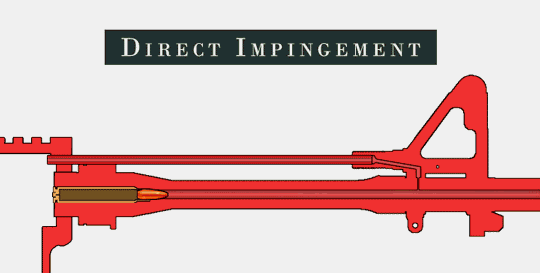AR-15 Gas Systems
When selling pistols, carbines, and rifles using the AR DI gas system, I always stress getting the longest gas system you can for the barrel you are using. This is why I primarily sell 16″ carbine systems with a mid-length gas system, and I suggest pistol buyers stick with the 10.5″ versions as they can use a carbine-length gas system. The article below gives you the facts behind the suggestion.

The gas port and tube that causes the bolt to cycle. These parts, from the gas port drilled in the barrel, through the gas block, tube, and the gas key in the bolt carrier, collectively make up the gas system. With a few (piston-driven or single-shot) exceptions that we won’t discuss here, pretty much all ARs cycle this way.
What changes, though, is the location of the gas port along the barrel. The gas port MUST be located far enough from the muzzle that the pressure has time to kick the bolt carrier back before the bullet exits about 1/4000th of a second later. That demands that the gas port be a certain size, and a certain distance from the muzzle — which actually varies, because pressures change as you go further from the chamber.
So shorter barrels need a shorter gas tube, and with the gas port closer to the chamber, the pressures are higher.
Not just a little higher, either. Dramatically higher.
Look at the chart below:
| Gas System | Gas Port Location | Pressure (PSI) |
|---|---|---|
| Pistol | 4.7″ | 48,300 |
| Carbine | 7.8″ | 33,000 |
| Mid-Length | 9.8″ | 26,500 |
| Rifle | 13.2″ | 19,600 |
This means the shorter your gas system is, the higher the pressures it’s subjected to. The bolt and carrier are slammed harder; they work harder, and the whole system becomes far more sensitive to anything that’s not perfect.
In addition, a shorter gas system is inevitably harsher in operation, because it has to cycle in a shorter time.
The original design was the rifle length system, and that’s what the gas system is designed around. At rifle length, an aluminum gas block is fine, which keeps weight down. But with the carbine length, the pressures are almost twice as high, and an aluminum gas block will eventually be eroded by the hot gas charges.
If you’re using a carbine length gas system, or even a mid-length, a steel gas block is recommended.
Also, as the gas systems get shorter, the size of the gas port increases, because they need to bleed off a lot of pressure in a shorter time. If the gas port is too small, the rifle will short-stroke, probably resulting in failures to feed. The port can be drilled larger, but this should be done by a qualified gunsmith, or you risk ruining the barrel.
On the other hand, if the port is too big, the rifle will be “overgassed.” That can send the gas impulse to the bolt too early, while the shell is still locked into the chamber by pressure, and cause it to fail to eject. At the very least, an overgassed rifle will be harsh to shoot. This can be addressed with an adjustable gas block, which lets you control how much gas bleeds through, allowing you to find the point where it cycles reliably.
For what it’s worth, most 14.5″ and 16″ barrels are set up for carbine gas systems, though you can find 16″ barrels with mid-length systems. The mid-length system (not an official standard, by the way, but an industry standard nonetheless) is commonly found on 18″ barrels, but they can be had with rifle length systems. And rifle length gas systems are standard on 20″ and longer barrels, and there’s NO reason to ever want to go shorter. In general, the longer your gas system is, the smoother and more reliably it’ll operate – though you do need a certain minimum dwell time after the bullet passes the gas port.






Recent Comments